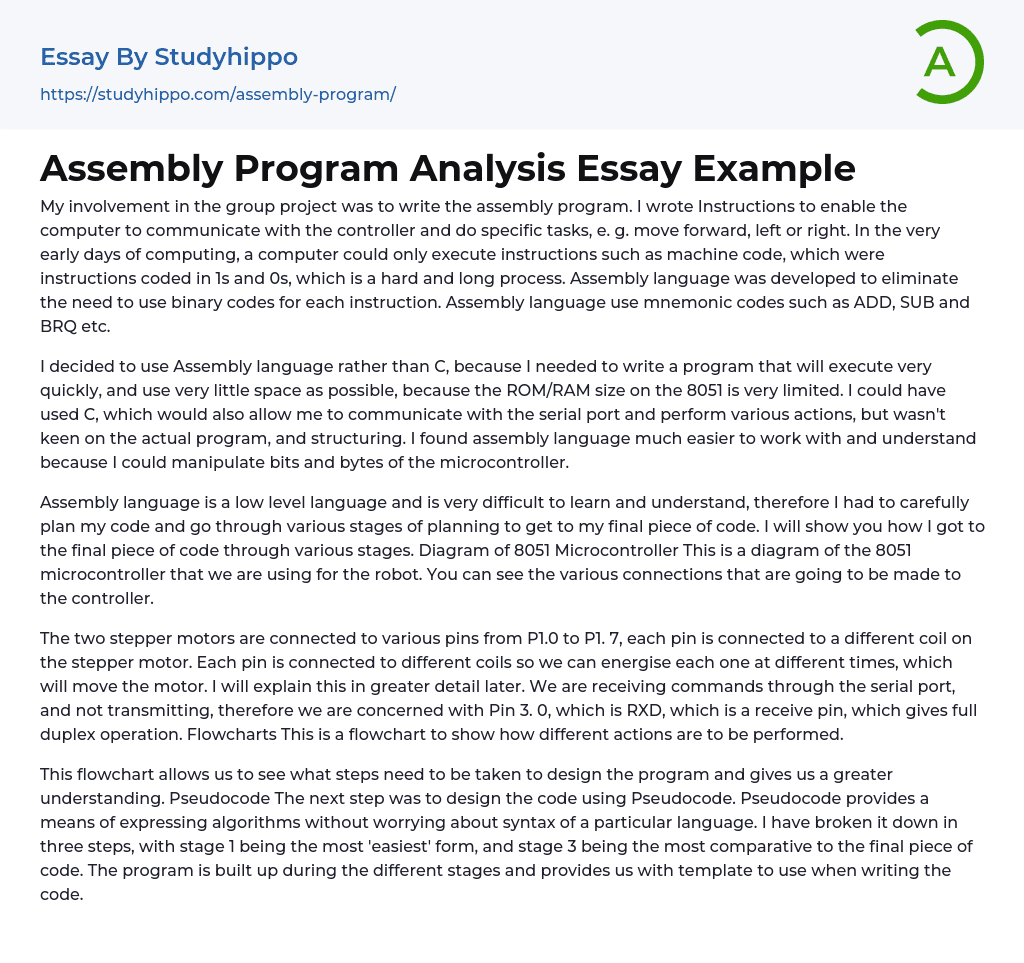My responsibility in the group project was to develop the assembly program. This entailed composing instructions that enabled the computer to engage with the controller and execute specific tasks, including various directional movements. During the initial phases of computing, computers solely comprehended machine code, which comprised intricate sequences of 1s and 0s. This procedure proved arduous and time-consuming. To streamline it, assembly language emerged as a solution. This language employs mnemonic codes like ADD, SUB, and BRQ in place of binary codes for each instruction.
I decided to use Assembly language instead of C because I needed to create a program that would run quickly and take up as little space as possible. This was necessary due to the limited ROM/RAM size on the 8051 microcontroller. While C would have allowed me to communicate with the serial port and pe
...rform various tasks, I wasn't comfortable with the program's actual implementation and structure. Assembly language, on the other hand, proved to be easier for me to work with and comprehend as I could directly manipulate the microcontroller's bits and bytes.
Assembly language is a challenging programming language to learn and comprehend. Consequently, I had to meticulously plan my code and progress through multiple planning stages in order to achieve my final code. I will demonstrate the progression towards the final code by detailing these stages. Presented below is a diagram depicting the 8051 microcontroller, which is the controller utilized for the robot. The diagram illustrates the various connections that will be established with the controller.
The two stepper motors are connected to various pins ranging from P1.0 to P1.7. Each pin is associated with a distinct coil on
the stepper motor, enabling individual energization for movement control. Additional details will be given later. Commands are received via the serial port, specifically Pin 3.0 (RXD), which facilitates full duplex operation. A flowchart depicting the sequence of actions is provided below.
This flowchart visually represents the steps required to design the program, providing a clearer understanding of the process. Pseudocode was utilized to design the code, enabling algorithm expression without being constrained by programming language syntax. The Pseudocode design is divided into three stages: stage 1 is the most basic form, while stage 3 closely resembles the final code. Each design stage builds upon its predecessor and serves as a blueprint for writing the actual code.
- Computer File essays
- Desktop Computer essays
- Servers essays
- Programming Languages essays
- Object-Oriented Programming essays
- Java essays
- Camera essays
- Cell Phones essays
- Computer essays
- Ipod essays
- Smartphone essays
- Computer Components essays
- Computer Peripherals essays
- Personal Computer essays
- Android essays
- Application Software essays
- Benchmark essays
- Computer Network essays
- Computer Programming essays
- Computer Security essays
- Computer Software essays
- Cryptography essays
- Data collection essays
- Data Mining essays
- Graphic Design essays
- Information Systems essays
- Internet essays
- Network Security essays
- Website essays
- World Wide Web essays
- Automobile essays
- Bus essays
- Civil engineering essays
- Cycling essays
- Electric Car essays
- Genetic Engineering essays
- Hybrid essays
- Innovation essays
- Internal Combustion Engine essays
- Invention essays
- Mechanical Engineering essays
- Mechanics essays
- Software Engineering essays
- Telephone essays




